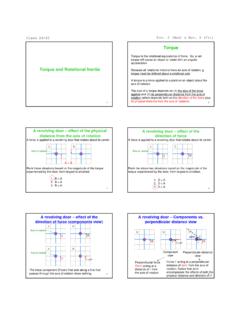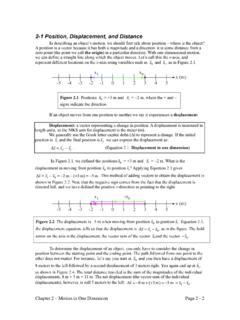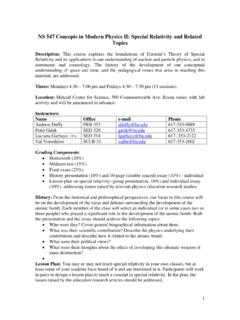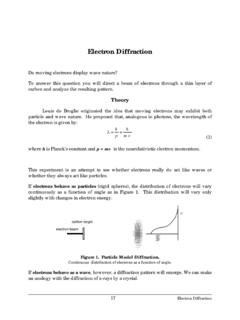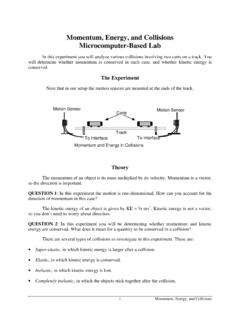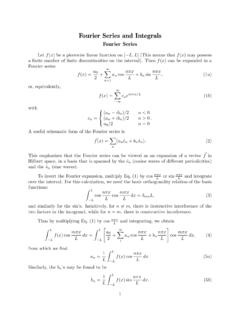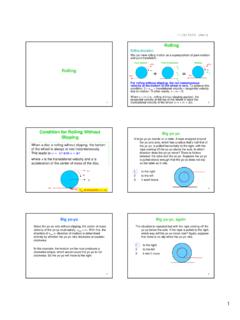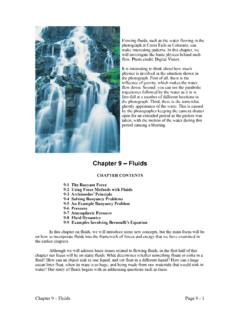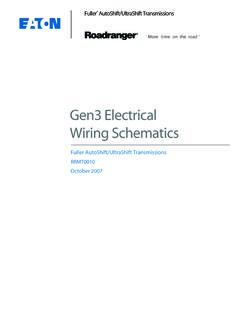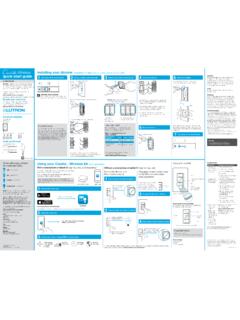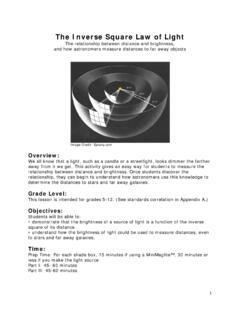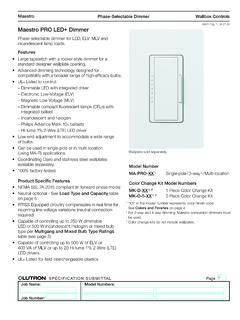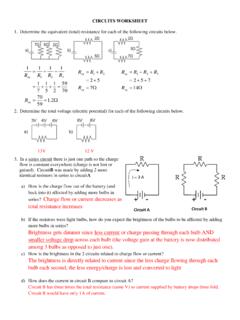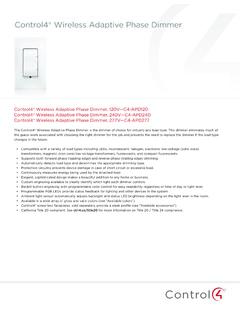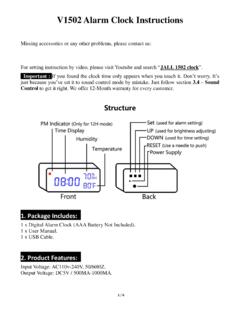Transcription of Resistance of a light bulb - Boston University
1 Resistance of a light bulbLet's use the power equation to calculate the Resistance of a 100 W light bulb. The bulb's power is 100 W when the potential difference is 120 V, so we can find the Resistance from: 2222120144100 VPIRRRVRP == === Resistance of a light bulbLet's use the power equation to calculate the Resistance of a 100 W light bulb. The bulb's power is 100 W when the potential difference is 120 V, so we can find the Resistance from: We can check this by measuring the Resistance with a ohm-meter, when the bulb is hot. 2222120144100 VPIRRRVRP == === Resistance of a light bulbLet's use the power equation to calculate the Resistance of a 40 Wlight bulb. The bulb's power is 40 W when the potential difference is 120 V, so we can find the Resistance from: 222212036040 VPIRRRVRP == === Resistors in seriesWhen resistors are in seriesthey are arranged in a chain, so the current has only one path to take the current is the same through each resistor.
2 The sum of the potential differences across each resistor equals the total potential difference across the whole chain. The I sare the same, and we can generalize to any number of resistors, so the equivalent Resistance of resistors in seriesis: 12 VVV=+123eqRRRR=+++L12eqIRIRIR=+Resistors in parallelWhen resistors are arranged in parallel, the current has multiple paths to take. The potential difference across each resistor is the same, and the currents add to equal the total current entering (and leaving) the parallel combination. The V s are all the same, and we can generalize to any number of resistors, so the equivalent Resistance of resistors in parallelis: 12 III=+12eqVVVRRR=+1231111eqRRRR=+++LLight bulbs in parallelA 100-W light bulb is connected in parallel with a 40-W light bulb, and the parallel combination is connected to a standard electrical outlet. The 40-W light bulb is then unscrewed from its socket. What happens to the 100-W bulb?
3 Turns gets gets dimmer (but stays on) at all it stays the sameLight bulbs in seriesA 100-W light bulb is connected in series with a 40-W light bulb and a standard electrical outlet. Which bulb is brighter? 40-watt 100-watt , they are equally brightLight bulbs in seriesThe brightness is related to the power (not the power stamped on the bulb,the power actually being dissipated in the bulb). The current is the same through the bulbs, so consider: We already showed that the Resistance of the 100 W bulb is 144 at 120 volts. A similar calculation showed that the 40 W bulb has a Resistance of 360 at 120 volts. Neither bulb has 120 volts across it, but the key is that the Resistance of the 40 W bulb is larger, so it dissipates more power and is bulbs in series, IIA 100-W light bulb is connected in series with a 40-W light bulb and a standard electrical outlet. The 100-W light bulb is then unscrewed from its socket. What happens to the 40-W bulb?
4 Turns gets gets dimmer (but stays on) at all it stays the sameBulbs and switchesFour identical light bulbs are arranged in a circuit. What is the minimum number of switches that must be closed for at least one light bulb to come on? Bulbs and switchesWhat is the minimum number of switches that must be closed for at least one light bulb to come on? and switchesIs bulb A on already? Bulbs and switchesIs bulb A on already? No. For there to be acurrent, there mustbe a complete paththrough the circuitfrom one batteryterminal to the and switchesTo complete the circuit, we need to close switch D, and either switch B or switch C. Bulbs and switches, IIWhich switches should be closed to maximizethe brightness of bulb D? 1. All four switches. 2. Switch D and either switch B or switch C 3. Switch D and both switches B and C 4. Switch A, either switch B or switch C, and switch D 5. Only switch D. Bulbs and switches, IIWhat determines the brightness of a bulb?
5 Bulbs and switches, IIWhat determines the brightness of a bulb?The a bulb of fixedresistance, maximizing power dissipated in the bulb means maximizing the current through the and switches, IIWe need to close switch D, and either switch B or switch C, for bulb D to come on. Do the remaining switches matter?Bulbs and switches, IIWe need to close switch D, and either switch B or switch C, for bulb D to come on. Do the remaining switches matter?Consider much of thecurrent that passesthrough the battery passesthrough bulb D?Bulbs and switches, IIWe need to close switch D, and either switch B or switch C, for bulb D to come on. Do the remaining switches matter?Consider much of thecurrent that passesthrough the battery passesthrough bulb D?All of and switches, IIIf we open or close switches, does it change the total current in the circuit?Bulbs and switches, IIIf we open or close switches, does it change the total current in the circuit?
6 Absolutely, becauseit changes the total Resistance (theequivalent Resistance )of the and switches, IIDoes it matter whether just one of switches B and C are closed, compared to closing both of these switches? Bulbs and switches, IIDoes it matter whether just one of switches B and C are closed, compared to closing both of these switches? Yes. Closing bothswitches B and Cdecreases theresistance of thatpart of the circuit,decreasing increases thecurrent in the circuit,increasing the brightnessof bulb D. Bulbs and switches, IIWhat about switch A? Bulbs and switches, IIWhat about switch A? An open switch is a path of _____ closed switch is a path of _____ and switches, IIWhat about switch A? An open switch is a path of closed switch is a path of and switches, IIWhat about switch A? Closing switch Atakes bulb A out ofthe circuit. Thatdecreases thetotal Resistance ,increasing the current, makingbulb D all 4 combination circuitHow do we analyze a circuit like this, to find the current through, and voltage across, each resistor?
7 R1= 6 R2= 36 R3= 12 R4= 3 A combination circuitFirst, replace two resistors that are in series or parallel by one equivalent resistor. Keep going until you have one resistor. Find the current in the circuit. Then, expand the circuit back again, finding the current and voltage at each circuit: rules of thumbTwo resistors are in series when the same current that passes through one resistor goes on to pass through resistors are in parallel when they are directly connected together at one end, directly connected at the other, and the current splits, some passing through one resistor and some through the other, and then combination circuitWhere do we start?R1= 6 R2= 36 R3= 12 R4= 3 A combination circuitWhere do we start?R1= 6 R2= 36 R3= 12 R4= 3 Resistors 2 and 3 are in combination circuit=+=+=+= 2323111111343612363636 RRR == 233694RA combination circuitWhat next?R1= 6 R23= 9 R4= 3 A combination circuitWhat next?R1= 6 R23= 9 R4= 3 Resistors 2-3 and 4 are in combination circuit=+= + = 2342349312 RRRNow what?
8 R1= 6 R234= 12 A combination circuit=+= + = 2342349312 RRRNow what? These resistors are in 6 R234= 12 A combination circuit=+=+=+= 123411111213612121212eqRRR == 1243eqRA combination circuitNow, find the current in the combination circuitNow, find the current in the V3 A4batterytotaleqVIR=== A combination circuitExpand the circuit back, in reverse combination circuitWhen expanding an equivalent resistor back to a parallel pair, the voltage is the same, and the current splits. Apply Ohm s Law to find the current through each resistor. Make sure the sum of the currents is the current in the equivalent combination circuitWhen expanding an equivalent resistor back to a series pair, thecurrent is the same, and the voltage divides. Apply Ohm s Law to find the voltage across each resistor. Make sure the sum of the voltages is the voltage across the equivalent combination circuitThe last identical bulbsThree identical light bulbs are connected in the circuit shown.
9 When the power is turned on, and with the switch beside bulb C left open, how will the brightnessesof the bulbs compare? 1. A = B = C 2. A > B > C 3. A > B = C 4. A = B > C 5. B > A > C Three identical bulbs, IIWhen the switch is closed, bulb C will turn on, so it definitely gets brighter. What about bulbs A and B?1. Both A and B get brighter 2. Both A and B get dimmer 3. Both A and B stay the same 4. A gets brighter while B gets dimmer 5. A gets brighter while B stays the same 6. A gets dimmer while B gets brighter 7. A gets dimmer while B stays the same 8. A stays the same while B gets brighter 9. A stays the same while B gets dimmer Three identical bulbs, IIClosing the switch brings C into the circuit -this reduces the overall Resistance of the circuit, so the current in the circuit increases. Three identical bulbs, IIClosing the switch brings C into the circuit -this reduces the overall Resistance of the circuit, so the current in the circuit increases.
10 Increasing the current makes A identical bulbs, IIClosing the switch brings C into the circuit -this reduces the overall Resistance of the circuit, so the current in the circuit increases. Increasing the current makes A V = IR, the potential difference across bulb A identical bulbs, IIClosing the switch brings C into the circuit -this reduces the overall Resistance of the circuit, so the current in the circuit increases. Increasing the current makes A V = IR, the potential difference across bulb A decreases the potential difference across B, so its current drops and B gets dimmer.

